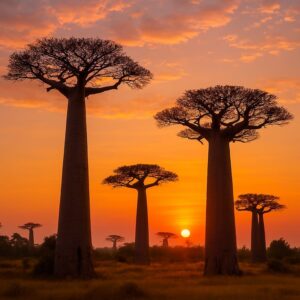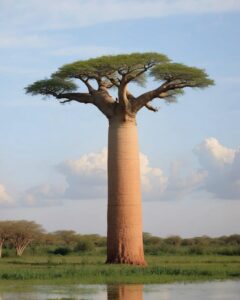
Kavindya Senevirathna



The baobab tree is one of the most unique and beautiful trees in the world. It is also known as the “Tree of Life,” a name that many people may not be familiar with. This is because it is a strong tree that has provided life, food, water, and health for thousands of years in Asia, Africa, and Australia. The image of the baobab tree looks as if it is held captive in a world of its own as if the roots of the tree are on the surface. Because of this appearance, it is considered a magical tree with special meaning in many forms of folklore.
Baobab trees have existed in the dry lands of Madagascar, Africa, and Australia for thousands of years, and they are a very important part of biodiversity and human culture. Scientifically known as Adansonia, there are about nine species of these trees. Of these, the most famous is the African baobab tree, Adansonia digitata. It has a large trunk, reaching a height of up to 25 meters and a trunk circumference of more than 10 meters. One of the unique features of the baobab tree is its ability to store water in its trunk. Even in dry seasons, it can survive by storing thousands of liters of water. That is why this tree is also called the “Tree of Life.”
For the people of rural Africa, the baobab tree is a sacred symbol associated with the environment. According to some beliefs, this tree is also said to have been planted by God as a punishment. That is, God was angry with this tree, and he planted it upside down. Because of this, the baobab tree still looks like a tree with its roots pointing upward. This appearance gives a lesson to humans never judge by appearance but look for the value inside.
The life cycle of the baobab tree, which begins with the growth of the plant, is very long and remarkable. Scientists say that this tree can live for about 3,000 years. Some trees have been alive since the days after the pyramids were built in ancient times. In other words, the baobab tree is a testament to the infinite life that has existed alongside the progress of human history. However, this long life exists because of its scientific adaptations. Although the number of leaves on baobab trees is limited, they have the ability to regenerate their leaves every year. In dry seasons, they shed their leaves to conserve water and energy.
Also, the living soft tissue (spongy tissue) in the trunk of the baobab tree retains a large amount of water. Therefore, the trees can survive even in extremely dry environments. The way these trees hold their branches appears like a magical image to schoolchildren. Scientists value it as a “mother tree” and a fundamental species in the protection of the environment.
The baobab tree is a very useful tree for human life. Its leaves, fruits, nuts in the form of eggs, and substances obtained from the trunk all have medicinal value. Baobab powder obtained from the tree’s nuts is now sold as a superfood in many countries. It is rich in nutrients such as vitamin C, calcium, magnesium, and potassium. African travelers still speak of the benefits of drinking beverages made from these nuts, even thousands of years later. Baobab leaves can also be used to make soups, curries, or medicines. The seemingly fibrous tissue obtained from the trunk has also been used by artists the baobab tree has become a tree that connects human creativity and culture.
Another important point is that this tree is closely intertwined with the social life of Africa. Villagers talk, remember, make offerings, or have good dreams under the baobab tree. The diversity of animals that make these trees their home is also great monkeys, birds, bats, bees, and an amazing variety of species. Therefore, the baobab tree provides a fundamental condition for environmental conservation. If it disappears, it will also take away the shelter for many living creatures.
Nowadays, baobab trees are facing the threat of extinction. Due to climate change, drought, and deforestation, several ancient baobab trees in Africa have died. According to scientists, this is a negative consequence of the increase in global temperatures. Therefore, the protection of these magnificent trees has become a serious responsibility for humans. However, when we look inside the baobab tree, we can see a profound lesson about the environment and life it can sustain life even in extremely dry conditions. It brings to mind strength, courage, and the true meaning of human resilience.
The baobab tree has also been a model for human artistry. In many paintings, poems, and songs, this tree is depicted as a symbol of life, connection, and harmony with the environment. In ancient African traditions, songs sung under the baobab tree are remembered by new generations. It is often symbolized as “the energy that keeps life moving.”
Even today, the baobab tree shows a very unique biological pattern. DNA research has found that the diversity of this tree was a significant factor in the global environment long before human interference. The genetic differences between the Australian baobab and the African baobab are considerable. But the same factor is common to all of them the ability to maintain life even after thousands of years.
This tree teaches humans the meaning of living in harmony with nature. The baobab tree is a tree that blooms happily even after a dry season. It also gives a message that we too can be strong in the dry seasons of life. If it is not nourished by the environment, it lives by drawing water from its own reserves that is also similar to our lives. We too need to move forward with our own strength, not relying on someone else.
The message shown by the baobab tree is simple when there is strength in the mind, there is no such thing as a dry season. It is not only a lesson about the environment but also about life. That is why this tree should be an example for future generations. Moreover, it can help us understand the value of environmental conservation and the interdependence of life. The baobab tree is the simplest, yet most profound tree in the world. Although it may appear distorted, it contains infinite life within.
So, when we think of the baobab tree, it is not just a tree that comes to mind it is a symbol of the biological and spiritual connection that humans share with nature. It shows that life is not a state without hardship but a way of learning to bloom in the midst of it. That is why the baobab tree has become an eternal treasure both in the human mind and on the earth.
I like your blog.